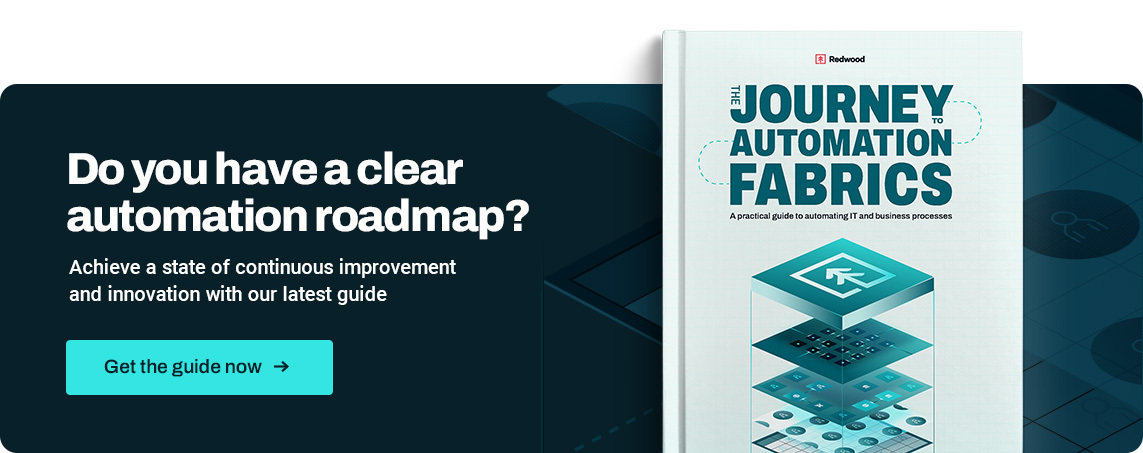Organizational culture and enterprise automation: 3 ways to drive change

When you think about what stands in the way of your organization achieving process autonomy via automation, you probably don’t think about human nature. You may be well aware of the technical issues plaguing your team, but what about their fears?
For many employees, automation still represents a threat. 22% of United States workers worry about technology making their jobs obsolete.
This shadow of uncertainty about the future of their roles magnifies a natural fear of the unknown. As much as you and fellow leaders may know that you’re not itching to replace human contributions, it’s a challenge to communicate the message that you’re looking to amplify them instead.
The right automation strategy frees up your people to leave repetitive tasks and outdated apps behind and do more of what humans excel at: strategic thinking, creative problem-solving and relationship-building. Unlocking all of these will require more than just deploying cutting-edge technology. We’ll cover the cultural shift you should invest in to help your employees view automation as a tool for enhancement rather than replacement.
Mindset matters in times of great change
When you’re in the midst of a significant digital transformation, like a cloud or ERP upgrade, collective mindset is everything. It’s a grueling process, and if the people you’re depending on to adopt new technologies don’t believe in or agree that there’s a need for them, your progress could grind to a halt.
Silos form, resistance builds and innovation fades away.
It’s essential for leaders to develop a partnership with employees — to set the tone for automation with an open, supportive culture to avoid these pitfalls. Use the guidance and real-world examples below to start making the change.

3 ways to help your employees prioritize automation
1. Align on automation-centric values
Values are the foundation of your organizational culture. Aligning automation plans with these values can help you get widespread buy-in. Moreover, making automation an original element of this foundation generates better results for your automation initiatives.
When automation is an afterthought, you might notice inconsistent outcomes. One Redwood Software retail customer had challenges with consistently meeting deadlines for their forecasting and replenishment (F&R) process for more than 10–15 days in a row, which resulted in not enough or the wrong items being stocked on the shelves. As they thought about how to improve the process, end-to-end automation and orchestration became key pillars in their strategy, along with improvements in their underlying ERP and planning systems. In the end, they achieved 30–40X the consistency, meeting SLAs 450 days in a row.
The key is to avoid embarking on your automation journey with the possibility of fragmentation. If your entire business moves as a unit with harmonized beliefs and intentions, your employees will feel more empowered and motivated to engage — a key ingredient for sustained operational efficiency and scalability.
This could look like:
- A pharmaceutical company places a strong emphasis on safety and compliance and uses automation to minimize human error in manufacturing. By framing automation as a way to uphold its commitment to patient safety, the leadership team turns potential resistance into enthusiasm. Employees understand that the technology will enhance their ability to deliver high-quality, safe products.
- A tech company values creativity and introduces end-to-end automation to eliminate administrative work and free up employees to innovate and develop new products. Leadership organizes “innovation days” or fun competitions to celebrate the time saved and further promote the idea that automation fuels rather than stifles creativity.
2. Establish a strong structure and dedicated automation team
When it comes to how you set up your organizational structure and team, automation cannot be something you’re merely exploring. It’s not a hobby but a primary means of getting where you want to go. Automation initiatives can only flourish in an environment where resources and responsibilities are well-defined.
At Redwood, we see that our most successful customers have a lifecycle-oriented approach driven by a centralized automation team. The first part of that lifecycle is educating teammates and customers about the art of the possible.
Fear and uncertainty thrive in an ambiguous environment. Clear, consistent communication is the antidote. Regular, straightforward dialogue can demystify automation and help your team understand how it will impact their specific use cases. It also reinforces the idea that automation is a collective effort and they’re not alone in experiencing frustration or having questions.
Even if your team is only comprised of two or three people, it’s crucial for inspiring all stakeholders and maintaining a shared sense of purpose.
The wrong way: A large healthcare provider attempts to introduce automation but allows each department to work independently. Lacking a unified strategy, they end up duplicating efforts and leaving critical projects unaddressed. Thus, they create inefficient workflows, realize little to no cost savings and see low adoption rates.
When it works: A global manufacturing company recognizes the complexity of implementing automation across its operations and creates a Center of Excellence (CoE) to gather input, prioritize projects and align with business goals. They apply resources in the most efficient way, thanks to an advanced workload automation platform, so they successfully automate 40% more processes and experience 64% fewer errors.
3. Support deeper automation long-term
Cultural buy-in and education are key, but they must work in practice. You need to be able to scale and integrate automation into diverse processes across your organization. That means getting the relevant teams involved in automation design and ensuring they do their part to get the systems running that can support those automations.
We recommend the following:
- Ask critical questions that push automation to new areas, such as: “How can we make our supply chain planning more predictable?” or “Could we close the books two days sooner?” These questions aren’t just about adding automation; they’re about reimagining processes to bring measurable business value, like reducing forecasting errors or accelerating financial closes.
- Scale thoughtfully by applying the lessons you learn in your first automations to more complex workflows and areas of the business. Create a cycle of continuous improvement, with your automation team evaluating and optimizing each automated process and considering how to inject automation into others.
As your automation capabilities mature, your automation team should never have to worry about people and their concerns or misunderstandings being a roadblock. Automation velocity will increase because your values, structure and scaling approach align.
Facilitate a fundamental shift
If you’re already undergoing a cloud or ERP transformation, you understand the importance of organization-wide buy-in. Maturing your automation demands the same level of cultural commitment. Clinging to archaic practices or allowing distrust to fester will only stand in the way of efficient processes and could even stall your company’s growth.
To ease the cultural change around automation and generate greater business value, first discover where you are on the path to automation maturity. Take our free, five-minute assessment.
About The Author

Devin Gharibian-Saki
Devin Gharibian-Saki brings a wealth of knowledge and expertise on enterprise IT, the SAP ecosystem and business process automation to his current role as SVP of Business Development and Strategy at Redwood Software. Experience within product marketing, product management and enterprise software sales enables Devin to drive strategic initiatives and alliances for the organization and unlock new business models and go-to-market strategies. Acting as an executive advocate for the customer, Devin is passionate about delivering the best solutions to make the most out of a customer’s environment. His approach centers on connecting with customers, prospects and partners to better understand how Redwood can help their digital transformation initiatives, improving their automation roadmaps by leveraging a combination of his SAP and process optimization proficiencies.
Prior to working for Redwood, Devin was an SAP Technology Consultant, working directly at SAP and at EnBW, the third-largest utility in Germany. Devin holds a diploma in Mathematics from Karlsruhe Institute of Technology in Karlsruhe, Germany, as well as two patents.